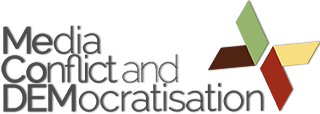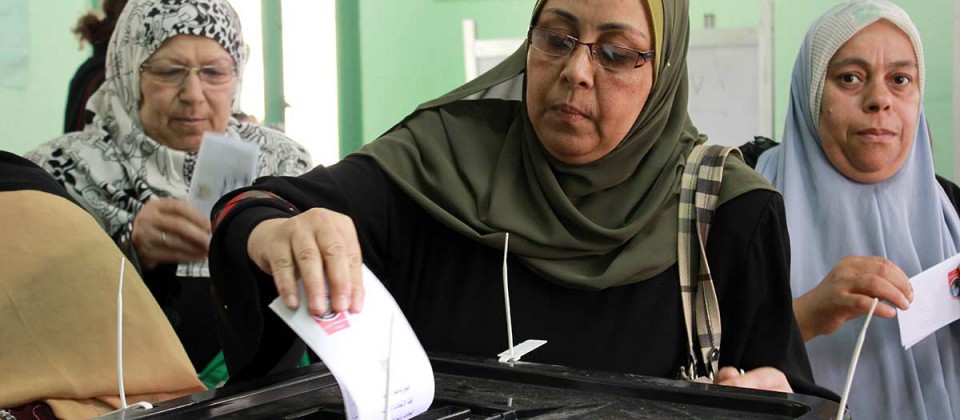- Overview
- Media Landscape
- Conflict Cases
- Conflict Case 1: Citizenship and collective identities – Christian-Muslim violence
- Conflict case 2: Distribution and control of power – Maspero incident
- Conflict Case 3: Elections – 2012 and 2014 Presidential election
Egypt – an Overview
The most populous and, traditionally, most influential Arab country, Egypt was one of the first countries to become involved in the so-called ‘Arab Spring’. In January-February 2011, unprecedented street demonstrations led to the resignation of Hosni Mubarak and opened a phase of political transition. Since 2011, moments of euphoria and hope alternated with episodes of violence and grief as Egyptians saw three different presidents sworn in and voted for two sets of substantial constitutional amendments. The eventual ascent to power of former Field Marshal Abdel Fattah el-Sisi showed the continuing influence exerted by the Egyptian army on the transitional process, while people’s demands for social justice and individual rights are still central in the political arena.
Egypt’s Media Landscape
Egypt is a major media powerhouse in the Arab world. Some key media outlets, including the widely-read Al-Ahram newspaper, remain under ‘semi-official’ governmental supervision, but in the past 20 years their role has been increasingly challenged by privately-owned newspapers. Satellite TV is arguably the main opinion-setter in the country and private TV channels were instrumental in the mobilization process before and after the 25th January 2011 revolution. Egypt also has the sixteenth highest number of internet users in the world and new media are widely attributed with a central role in the build-up of the 25th January revolution.
Conflict Cases
The Egyptian team will analyse four individual cases that cover two broad typologies of democratisation conflicts and the two main phases of Egypt’s transition between 2011 and today – the period before and after the ousting of Mohammed Morsi in July 2013.
|
TYPES OF CONFLICT |
||||
| Citizenship and collective identities |
Distribution and control of power |
Elections | ||
| PHASES | ‘Open-ended’ transition (2011-13) | 2011 Maspero Incident | 2012 Presidential election | |
| ‘Pacted’ or ‘halted’ transition(2013-14) | Christian-Muslim violence in July-August 2013 | 2014 Presidential election | ||
Conflict Case 1:
Citizenship and collective identities – Christian-Muslim violence
This episode of religious violence is a manifestation of the multiple dimensions of sectarian conflicts. Mobilization against President Mohamed Morsi, the leader and the candidate of the Muslim Brotherhood-backed Freedom and Justice Party, was rapidly building up since late 2012. By June 2013 protests against President Morsi reached a peak, creating a situation conducive for the military intervention of July 3rd when the elected President was ousted. Many Copts were among the vocal critics of the ousted president, a position shared by mainstream Muslims. But for Islamic political activists meanwhile, while the anti-Muslim Brotherhood position of mainstream Muslims was politically interpreted, the same position taken by Egypt’s Copts was interpreted on a sectarian basis. Tensions and mistrust between Copts and Islamists thus reached an all-time high.
Against this background, violence against individual Coptic citizens, communities, and churches during the summer of 2013 took place. This violence was mainly an extension of the power struggle between political factions in which Copts as a community got caught in the middle. The violent attacks directed against Copts were, to a large extent, deliberate acts orchestrated by Islamic activists rather than a spontaneous outbreak of violence between people of different religious convictions. The essence of the summer of 2013 sectarian conflict was whether or not Copts are entitled to equal citizenship rights, allowing them to voice their political views without being stigmatized for their religious beliefs.
Conflict Case 2:
Distribution and control of power – Maspero incident
While the January 2011 revolution was an important moment of inter-communal collaboration in Egypt, it was also followed by one of the most severe attacks on the Coptic community in recent history. One of the main incidents are the demonstrations in front of the headquarters of the Egyptian Radio and Television Union (so-called Maspero building) in which 28 demonstrators lost their lives in a confrontation with security forces and the military. The incident marks a process of politicisation of religion in Egypt, resulting in the emergence of new political actors and broadcast channels with explicit religious affiliation.
Conflict Case 3:
Elections – 2012 and 2014 Presidential Elections
The two elections in 2012 and 2014 are crucial turning points in post-revolution Egypt and together reflect the uncertain outcome of the political transformations that are taking place in the country. In 2012, Mohammed Morsi, leader of the Muslim Brotherhood’s Freedom and Justice Party won the first democratic election in Egypt with less than 52% of the vote, with a turnout of only 46 and 52% in the first and second round respectively.
After Morsi’s ousting in 2013, the election in May 2014 confirmed General El-Sisi as president with an overwhelming majority of 97%, even though less than half of Egyptians (48%) turned out to vote. The campaigns for both elections demonstrate the polarisation and limitations of public communication and the role the media are playing in the political power struggles in Egypt today.

